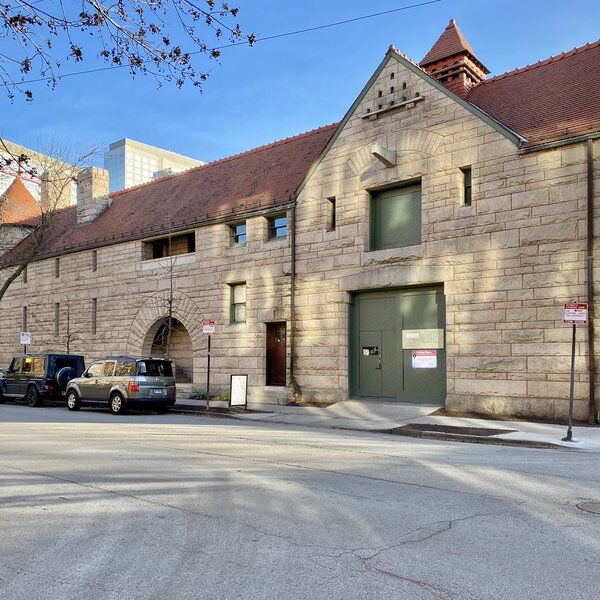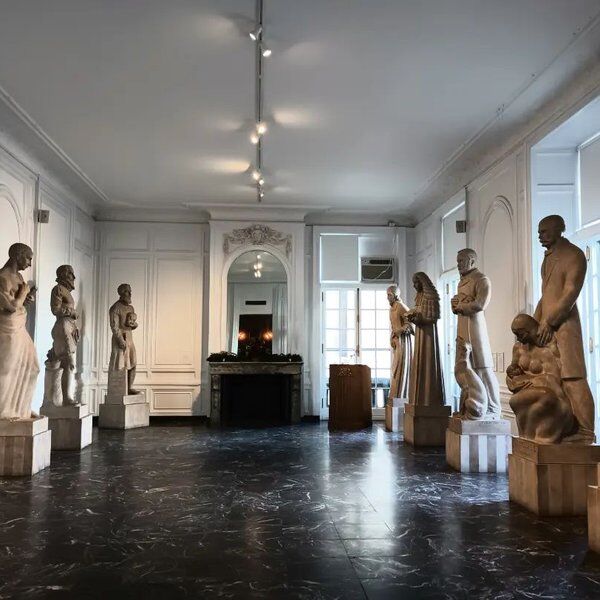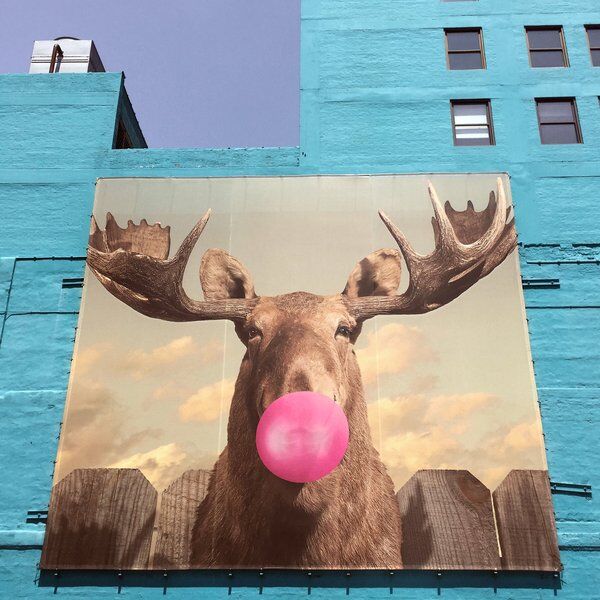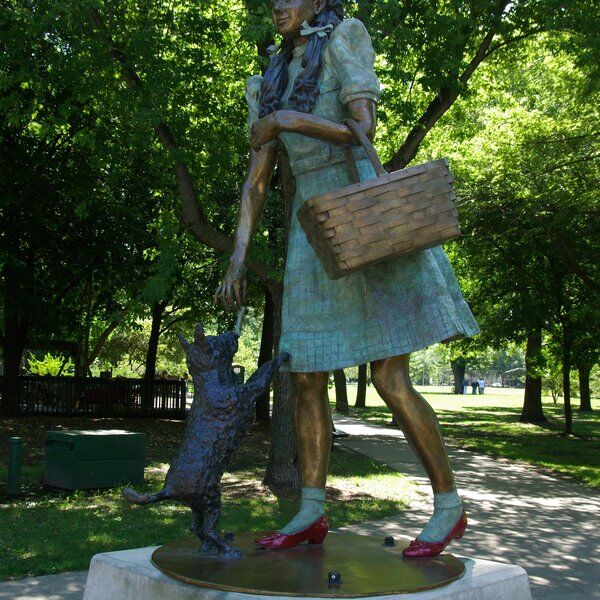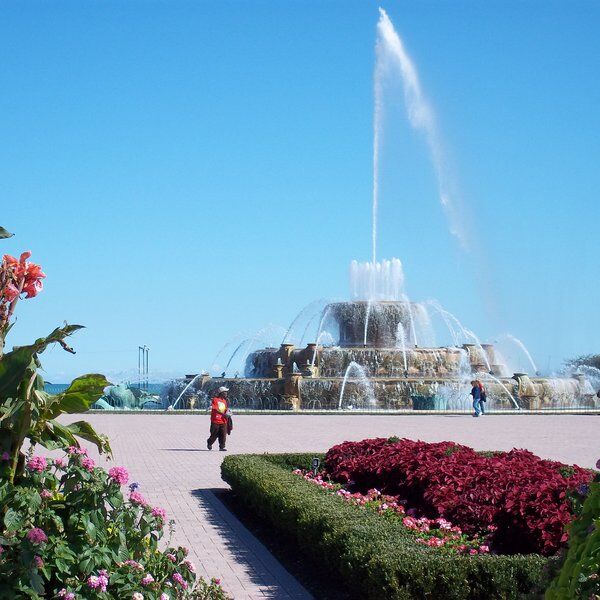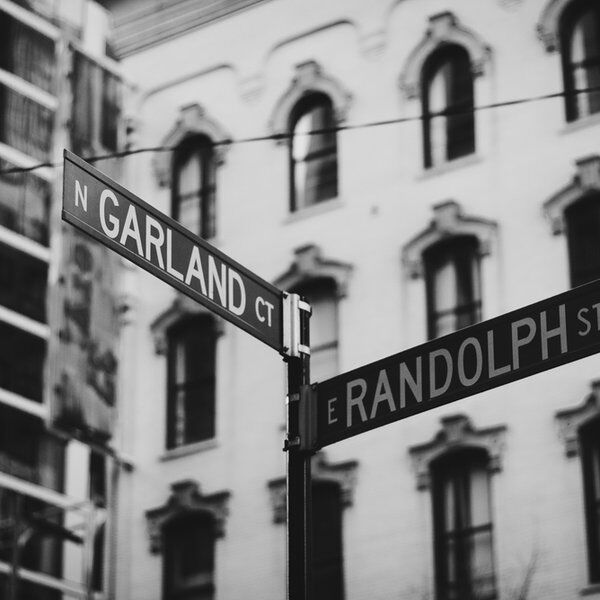Discover Graceland Cemetery in Chicago
Situated on the busy north side of Chicago, Graceland Cemetery is a beautiful, 119-acre burial ground popular for its park-like quality. Established in 1860, this cemetery is both a final resting place for some of Chicago's most prominent figures and an architectural masterpiece. Its original design aimed to transcend the overcrowded and somber urban graveyards of the 19th century, embracing the principles of the rural cemetery movement, focused on creating park-like settings instead.
Today, Graceland Cemetery remains an active burial ground and contains beautiful landscapes, winding pathways, and even houses a certified arboretum, alongside some unique monuments, whose creators are even buried there.
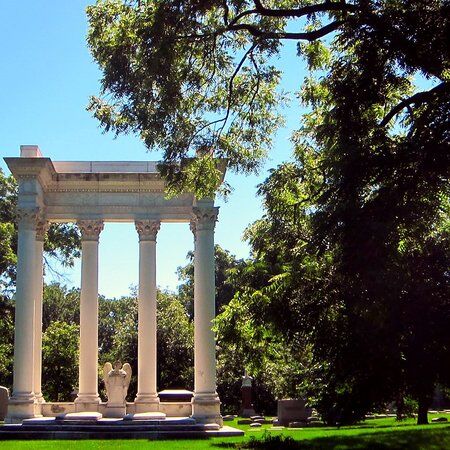
History of Graceland Cemetery
Graceland Cemetery was founded in 1860 by Thomas Bryan, a successful lawyer who envisioned a more picturesque, park-like cemetery for Chicago's residents. Dissatisfied with the conditions of Chicago’s City Cemetery, Bryan sought to create a space that was not only a final resting place but also an area of reflection and beauty. Initially established on 80 acres of land, the cemetery received its perpetual charter in 1861, securing its status as a private burial ground.
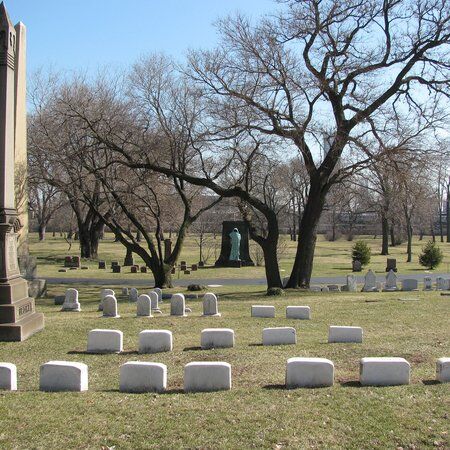
Design and Features of Graceland Cemetery
Early Design
Graceland Cemetery’s design has evolved over time, beginning with the vision of landscape architects H.W.S. Cleveland and William Le Baron Jenney in its early days. Their goal was to create an inviting and natural atmosphere characterized by sweeping pathways, lush greenery, and open spaces. This foundational design aimed to reflect the ideals of the rural cemetery movement.
Prairie Style Landscape Design
By the late 19th century, landscape architect Ossian Cole Simonds took the cemetery's design to new heights. As the cemetery’s superintendent and lead landscape architect, Simonds built on the earlier design to further the popular park-like environment that defines Graceland today. He used native plant species to enhance the cemetery's views and tranquil atmosphere, embodying the Prairie style of landscape architecture.
Simonds’ innovative work earned international recognition when Graceland Cemetery was awarded a medal of excellence at the 1900 Paris Exposition. His legacy continues to influence landscape architects and historians.
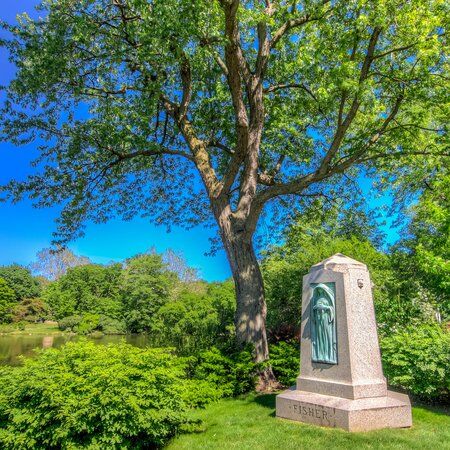
Central Lake and Certified Arboretum
One of Graceland Cemetery’s most striking features is its central lake, which adds a reflective and peaceful quality to the space. Many of the cemetery’s most famous gravesites are located around this serene body of water. The lake, combined with meandering paths and pastoral plantings, creates an environment that encourages contemplation and reflection.
The cemetery is also home to over 2,000 trees and is a certified arboretum. Its diverse landscape includes oak, ash, witch hazel, and dogwood trees, many of which were planted as part of Simonds’ vision to create a more naturalistic setting.
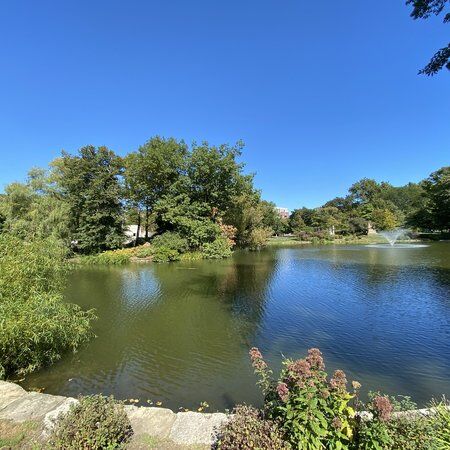
Monuments
While most cemeteries contain a variety of monuments, few are as impressive as those at Graceland.
- Cyrus McCormick Monument: Dedicated to the inventor of the mechanical reaper, this grand obelisk symbolizes McCormick's monumental contributions to agriculture and industry. It is a prime example of 19th-century funerary architecture.
- Marshall Field Memorial: Designed by Henry Bacon, who also designed the Lincoln Memorial, this monument honors the retail magnate Marshall Field. The structure features a somber figure of a woman, sculpted by Daniel Chester French, and is known for its intricate details and commanding presence.
- The Getty Tomb: Designed by Louis Sullivan, who is now buried there, this tomb combines Art Nouveau elements with classical forms. Celebrated for its intricate ornamental ironwork and bold design, it stands out among the cemetery’s traditional styles.
- The Palmer Mausoleum: Reflecting the grandeur of the Gilded Age, this neoclassical mausoleum houses Potter Palmer and his wife, Bertha Honoré Palmer. Its massive stone columns and ornate sculptures symbolize the wealth and influence of the Palmer family.
- Burnham Memorial: Honoring Daniel Burnham, the renowned urban planner and architect, this simple yet elegant boulder marker contrasts with Burnham’s grand architectural achievements.
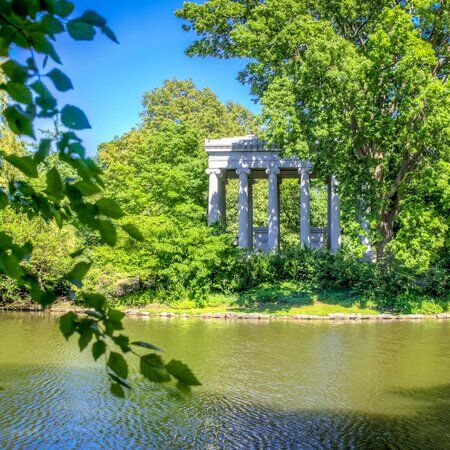
Who is Buried at Graceland Cemetery?
Graceland Cemetery is the final resting place for some of Chicago's most influential figures, representing various sectors such as business, industry, and the arts. Here, we explore a few notable individuals who have left an indelible mark on the city's history:
Architects
Graceland Cemetery is often referred to as the "Cemetery of Architects" due to its association with some of Chicago’s most celebrated designers.
Here are just some of the architects buried at Graceland Cemetery:
- Louis Sullivan (1856–1924): Known as the "Father of the Chicago School of Architecture," Sullivan’s work laid the foundation for modern skyscrapers. His grave at Graceland is modest, a stark contrast to the monumental designs he created, such as Chicago’s Carson Pirie Scott Building.
- Daniel Burnham (1846–1912): Famous for his grand vision of urban planning and his involvement in the 1893 Columbian Exposition, Burnham’s motto, “Make no little plans,” is still remembered today. His grave on a small island within Graceland’s lake is a peaceful tribute to his contributions.
- Richard Nickel (1928–1972): As an architectural photographer and preservationist, Nickel is remembered for his efforts to save the works of architects like Adler & Sullivan. Tragically, he died while salvaging materials from the demolished Stock Exchange Building.
- Fazlur Khan (1929–1982): An engineering genius, Khan revolutionized skyscraper design, most notably the Sears Tower. His contributions to the field are recognized globally.
- William Le Baron Jenney (1832–1907): Known as the "Father of the Skyscraper," Jenney designed the first metal-framed building, laying the groundwork for the modern high-rise. His ashes were scattered over his wife’s grave at Graceland, though a memorial now marks his place in history.
- Marion Mahony Griffin (1871–1971): The first licensed female architect in the U.S. and a close collaborator of Frank Lloyd Wright, Mahony Griffin's work helped shape the Prairie School. Her contributions, particularly in the design of Australia’s capital, Canberra, are remembered with a plaque at her final resting place.

Public Figures and Private Eyes
Graceland is also home to many prominent public figures and even a few detectives and politicians who played pivotal roles in Chicago’s history.
Here are just some of the public figures and private eyes buried at Graceland Cemetery:
- Charles Wacker (1856–1929): As chairman of the Chicago Plan Commission, Wacker was instrumental in gaining public support for the 1909 Chicago Plan. His legacy is immortalized not only in the city’s design but also in the naming of Wacker Drive.
- John Peter Altgeld (1847–1902): Altgeld, a former Illinois governor, made controversial decisions that marked his career, including pardoning anarchists involved in the Haymarket Riot. His progressive views on labor and prison reform left a lasting impact.
- Joseph Medill (1823–1899): The influential editor of the Chicago Tribune and former mayor of Chicago, Medill was known for his strong political stances, particularly against slavery and labor unions. His time as mayor saw the establishment of Chicago’s public library system.
- Alan Pinkerton (1819–1884): Famous for founding the Pinkerton National Detective Agency, Pinkerton was also an abolitionist and played a role in protecting President Lincoln. He is buried near his top agents, including Kate Warn, the first female detective in the U.S.
- John Jones (1816–1879): One of Chicago’s earliest Black political leaders, Jones was a self-educated tailor who advocated for the rights of African Americans. He also served as a county commissioner and worked to change laws that restricted the rights of Black citizens.
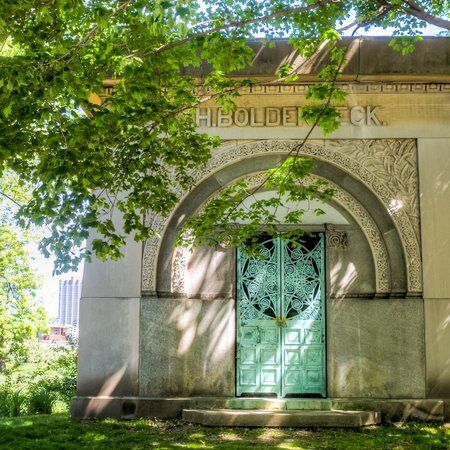
Sporting Legends
There are not just political figures buried in Graceland, but some of the greatest names in sports history, particularly from the worlds of baseball and boxing.
Here are just some of the sporting figures buried at Graceland Cemetery:
- Adrian "Cap" Anson (1852-1922): Cap Anson was a baseball legend and one of the first stars of Major League Baseball. He played for the Chicago White Stockings (now the Cubs) and was one of the most dominant hitters of his era.
- Charles Comiskey (1859-1931): A larger-than-life figure in baseball, Charles Comiskey was a founding owner of the Chicago White Sox and an instrumental figure in the creation of the American League.
- Jack Johnson (1878-1946): The first African American world heavyweight boxing champion, Jack Johnson's career was marked by his prowess in the ring and his defiance of racial boundaries in the early 20th century. Johnson's 1908 victory over Tommy Burns and his subsequent fights made him a global icon, but his life was marred by personal struggles and racial tensions.
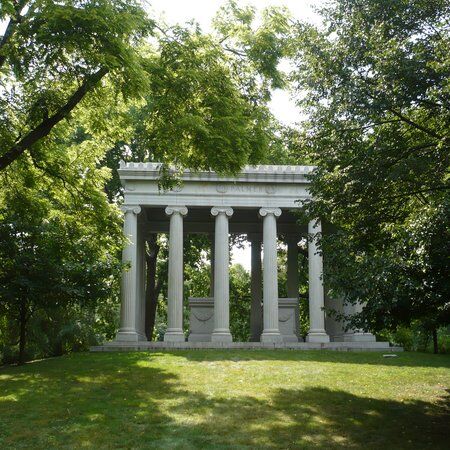
Business Figures
Chicago has long been a hub of commerce and innovation, and several of the city's pioneering figures have found their final resting place at Graceland Cemetery.
Here are just some of the sporting figures buried at Graceland Cemetery:
- Victor Lawson (1850-1925): Victor Lawson was the publisher of the Chicago Daily News, a newspaper that revolutionized global reporting by sending correspondents around the world.
- George Pullman (1831-1897): Known for inventing the luxury sleeping car for railroads, George Pullman also gained notoriety as the owner of the Pullman company town, where workers' grievances led to one of the most famous labor strikes in U.S. history.
- Phillip Armour (1832-1901): Armour was one of the titans of Chicago's meatpacking industry. Alongside competitors Swift and Libby, Armour helped transform the Union Stock Yards into an economic powerhouse, revolutionizing how meat was processed and distributed.
- Cyrus McCormick (1809-1884): The inventor of the mechanical reaper, McCormick revolutionized agriculture and built a vast industrial empire in Chicago. Though he achieved immense wealth, his headstone is notably modest, a reflection of his desire to maintain a simple legacy.
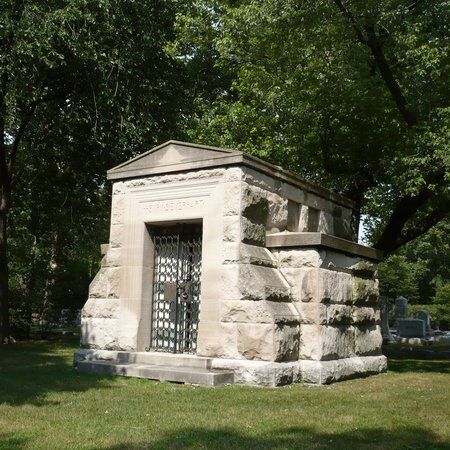
Underground Railroad Activists
Graceland Cemetery is not just a resting place for industrialists and socialites but also at least 29 activists who risked their lives to assist enslaved people escaping to freedom along the Underground Railroad.
Here are just some of the Underground Railroad Activists buried at Graceland Cemetery:
- Isaac Newton Arnold: A politician and attorney, Isaac Arnold was known for defending those arrested for helping escaped slaves. He also played a critical role in securing funding for the Illinois and Michigan Canal, which was a key route for freedom seekers heading toward Chicago and beyond.
- John Jones and Mary Richardson Jones: John Jones was a free Black man born in North Carolina who became a successful tailor and leader of Chicago’s Black community. Together with his wife Mary, they not only sheltered escaped slaves in their home but also hosted abolitionist leaders such as Frederick Douglass and John Brown.
- Allan Pinkerton: Best known as the founder of the Pinkerton National Detective Agency, Pinkerton was also a fervent abolitionist who sheltered freedom seekers in his suburban home. His contributions to the Underground Railroad extended into his professional life, as he helped plan escape routes and even trained those fleeing slavery in his trade of barrel-making.
For more information about the Underground Railroad, why not read these relevant articles:
- Underground Railroad Museum - Philadelphia.
- National Underground Railroad Freedom Center - Cincinnati.

The Dickens Family and Other Notables
In a strange twist, this Chicago Cemetery is also home to some unexpected individuals including:
- Augustus Dickens (1827-1866): The younger brother of famed author Charles Dickens, Augustus led a tumultuous life in Chicago, marked by business failures and personal hardships. His life seems almost like something his brother might have written—full of Dickensian irony.
- Eli Williams (1799-1881): One of Chicago's early settlers, Eli Williams was an entrepreneur who made his fortune in real estate and civic engagement. His Victorian-style monument, with a statue of a vine-clad woman holding a cross, at Graceland reflects the grandeur of his success.
Visiting Graceland Cemetery
Graceland Cemetery is open to the public daily from 8:00 am to 4:30 pm. Though it is home to many famous and wealthy individuals, the cemetery's design ensures that it remains an accessible and welcoming space for all. Visitors are encouraged to wander through the grounds and explore the various styles of gravestones, mausoleums, and sculptures.
There are two types of tours available at the cemetery: The Arboretum Tree Tour and a Self-Guided Tour. For the self-guided exploration, Graceland Cemetery provides downloadable maps and guides from their website, which highlight the graves of famous figures, making it easy to navigate the sprawling grounds.
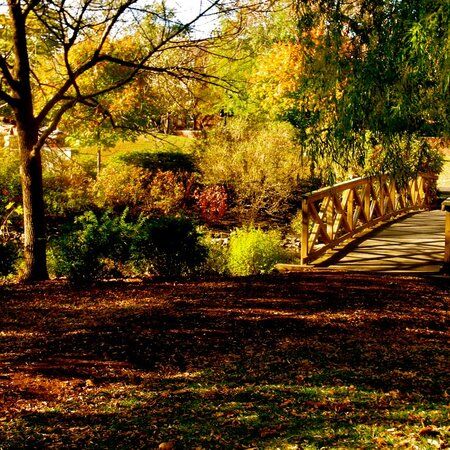
Explore Beyond Graceland Cemetery with CityDays
While Graceland Cemetery offers a fascinating glimpse into Chicago's history, the city has even more to discover beyond its gates.
CityDays offers exciting scavenger and treasure hunt tours across Chicago, perfect for groups looking for a fun and interactive way to explore the city’s hidden gems. These tours are ideal for corporate team-building exercises, family outings, or anyone looking to experience Chicago in a new light.
And if you’re inspired to travel further, CityDays offers similar tours around the world, combining adventure and history in every corner of the globe.











